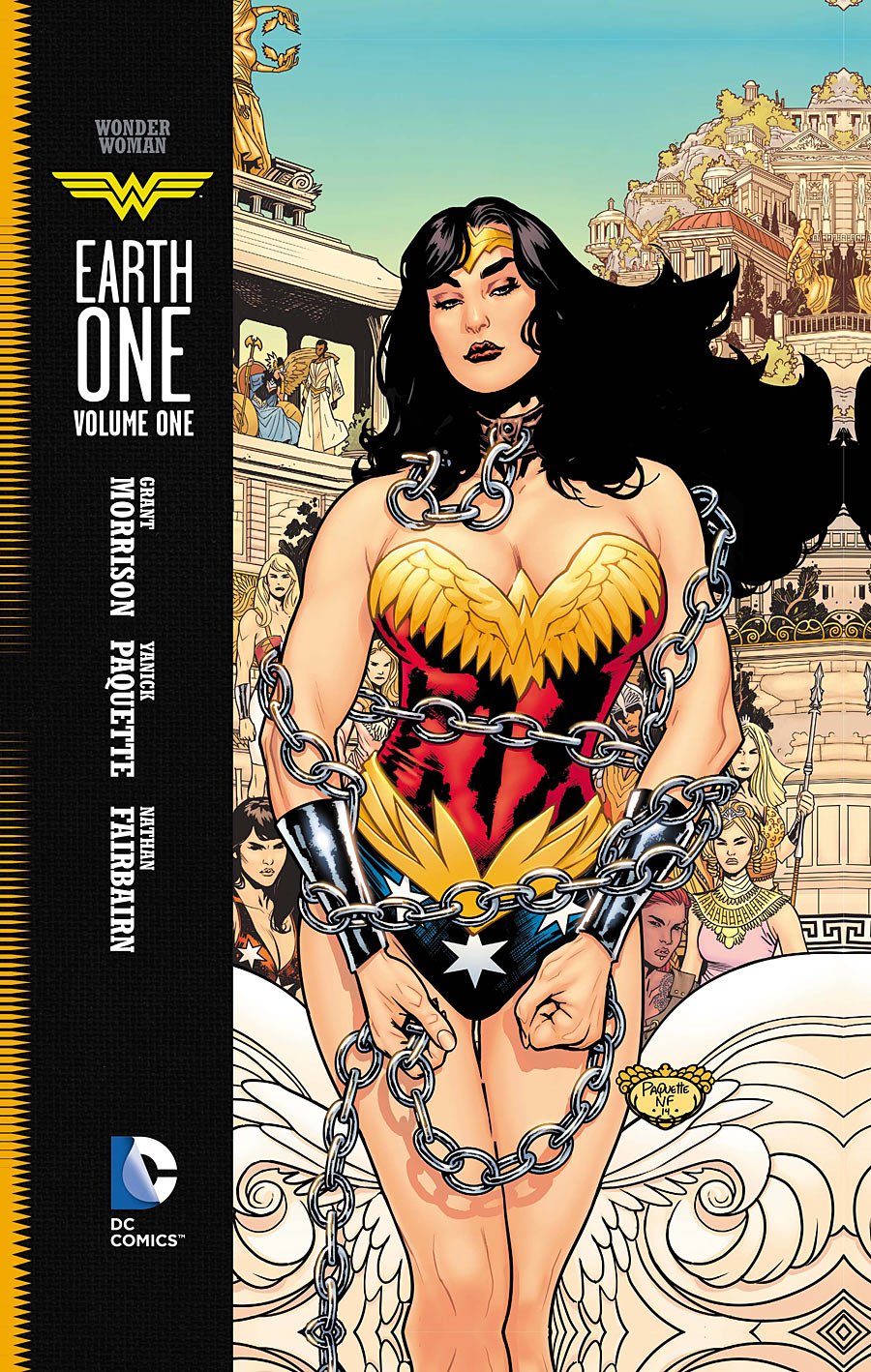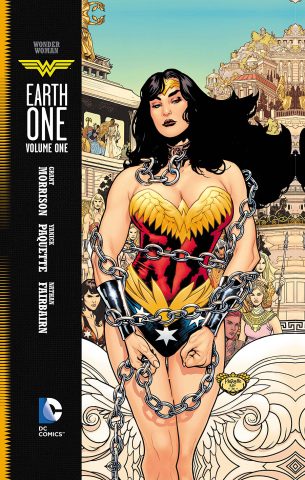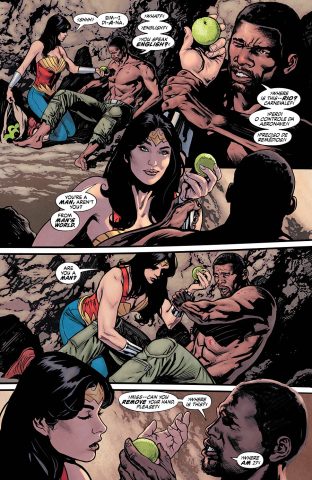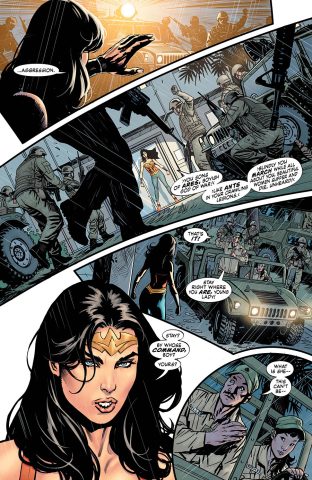Grant Morrison Talks Changes to Diana’s Origin and Steve Trevor in Wonder Woman: Earth One

It’s a great time to be a Wonder Woman fan. Not only is there an actual Wonder Woman film that’s actually being made, but one of comics’ finest loonies, Grant Morrison, along with artist Yanick Paquette is taking on the Amazonian princess in a new graphic novel called Wonder Woman: Earth One (Volume 1 – as in, there will be more volumes!), which is due out next month.
In a recent interview with Comic Book Resources, Morrison talked about how he has retold Diana’s origin story — both what he’s kept, and what he thought needed changing/updating — and how the women in his life influenced the way he writes her coming of age, and her relationship to Hippolyta.
On what sparks Diana going to “Man’s World”:
I thought the World War II origin really didn’t work anymore. And that was quite a big part of the original, which was that she decided to go and help fight the war and obviously that doesn’t apply in the same way anymore. What interested me more was that rather than she went and the Amazons were happy for her to go and her mother wanted her to go to man’s world or even that she went to man’s world because she fell in love with Steve Trevor, I liked the idea that her mother didn’t want her to go.
[…]
What I also wanted to talk about with Wonder Woman was the relationship that my sister and my mother had, which was two beautiful women who were very strong and very antagonistic. I really want to do that in the book. A lot of the women that I have known have had similar relationships with their mothers. I thought of it having more dynamism if there is a little bit of tension between Hippolyta and Diana versus the original story where they are very supportive of each other.
The same went for Steve Trevor. I didn’t like the idea that Diana instantly fell in love with Steve Trevor because it seemed too pat. I also wanted to see that whole thing develop a bit more. Steve becomes more of an excuse for her to come off the island rather than the reason that she comes off the island.
On updating Steve Trevor:
Steve Trevor was always sort of this boring, blonde, blue-eyed dude and that just didn’t cut it in the modern world. I wanted some diversity. But I also thought that was a much more potent idea to have Steve Trevor as a Black man. It’s much more powerful in the context of everything that Marston was doing and everything that Wonder Woman is about.
In a story that has to do with chains and bondage, there is a lot more resonance by what we choose to do with Steve. When he arrives on the water, we wanted to do a complete opposite of [Sandro] Botticelli’s [The Birth of] Venus. When Steve rises from the water, he’s in the position of Botticelli’s Venus. His parachute is around his feet like the half-shell. He plays a feminine role in the story but I figured that Steve Trevor was always too feminine to play the feminine role that he did. And that’s why he became boring and just fell into the background. I wanted him to be much stronger and much more ambiguous because through the story, we can never tell if Steve is lying or not. The story is about truth and lies and a lot of the characters lie. We wanted ambiguity and we wanted tension and we wanted drama.
On paying homage to Wonder Woman creator, William Moulton Marston:
I think Marston has to definitely be seen as one of the pantheon of great originators within comics. And I think what’s most interesting about him is that while Siegel and Shuster were bringing in the influence of immigrant kids during the Great Depression and Bob Kane and Bill Finger were bringing in wealth but also a dark strand to comics, I think what Marston brought in was actually counter-culture and alternatives, which I think has since become a part of comics all the way through.
Superman was rich in science fiction and Batman was crime and mystery, but with Wonder Woman you were getting the influences of alternative culture and total feminism. It was all about magic and weirdness, too, with alternative lifestyles and alternative ideas, which was basically reflective of Marston’s entire life. That’s what he was. He was part of alternative culture. As a result, I think Wonder Woman has always emboldened that strand. And that’s what makes her so strange. The character has been portrayed in lots of different ways. We’ve had the girl scout version. We’ve had the warrior version. But really, she comes from a much stranger tradition. And that’s what I found out about her and what I became interested about her as a character.
If you check out the full interview over at Comic Book Resources, you can also look at a gallery of preview pages from the book.
Full disclosure, while I’m really excited to see Gal Gadot play Wonder Woman in the upcoming solo film, and I’ve certainly encountered Wonder Woman as a character in various team books and in animated series (and Lynda Carter – duh!), I’ve never read Wonder Woman’s solo title in any of its incarnations. One, because I tend to read more Marvel than DC anyway, but two, because the discourse surrounding the character and the title always seems to revolve around “getting her right” vs. “getting her wrong” so much so that I feel discouraged reading any of it.
I started reading J. Michael Straczynski’s Wonder Woman: Odyssey, and even though I was kinda digging it, as I tend to dig Straczynski’s work, I felt so bombarded by opinions about how that version of her was “wrong” and how everyone hated her jacket and pants (which I thought looked really good), that I just…stopped. Which sucks. And which is why it’s so important to 1) not hold the female characters in comics to an unreachable high standard simply because they’re the only women in these stories, and 2) have more female characters, so that everything doesn’t rest on the shoulders of a select few.
Be that as it may, I’m a huge fan of Morrison’s, and I’m really looking forward to getting truly started with Wonder Woman in a story that’s less beholden to the past than it is beholden to the truth of the present.
That said, there’s a lot that Morrison describes in this interview that could go very right, or could go very wrong if he’s not careful. Let’s just start with a black Steve Trevor and a story about “chains and bondage.” I’m not saying that a poignant, impactful story can’t be told with those elements…but you’d better have a damn good point to make, and you’d better make it well, and make it respectfully. Then there’s the issue of Diana’s relationship with Hippolyta. On the one hand, it’s refreshing to see a mother-daughter relationship with some meat on it, and it’s very true that relationships between mothers and daughters are complicated, and often full of conflict. That said, this could be taken too far, and inject a competitiveness and a distrust between women into a story that is trying to be the opposite of that.
I suppose we’ll all see how her new origin unfolds and how Morrison handles all these tricky elements when Wonder Woman: Earth One, Vol. 1 drops on April 6th.
(images via DC Comics)
—The Mary Sue has a strict comment policy that forbids, but is not limited to, personal insults toward anyone, hate speech, and trolling.—
Follow The Mary Sue on Twitter, Facebook, Tumblr, Pinterest, & Google+.
Have a tip we should know? [email protected]


